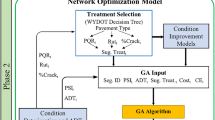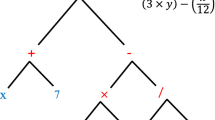Abstract
Pavement management and optimization tools at the project level provide designers and decision-makers with an optimal and sustainable solution. This research aimed to optimize pavement-designed sections by employing the multi-objective optimization model (MOOM) and the Highway Development and Management Model Four (HDM-4). The study analyzed 14 distinct designs of low-volume road (LVR) asphalt pavement structures across four climate zones, considering five types of subgrades and four types of traffic volume. Based on the analysis results, it is important to note that, although the selected pavements using MOOM and HDM-4 had lower discounted costs compared to the designed pavements (with reductions of 2.41 and 1.54%, respectively), the optimized pavement structures suggested by these two methods were not identical. In other words, in most cases, the analysis indicated that HDM-4 tended to prefer pavement structures with greater bearing capacity, while MOOM often favored structures with lower bearing capacity. Additionally, the discounted costs of the structures optimized using MOOM were 4.58% less than those of the structures optimized using HDM-4.









Similar content being viewed by others
Data availability
Available upon request from the corresponding author.
References
Trejo D (2023) Special issue on adaptive planning for sustainable and resilient infrastructure II: an Introduction. Sustain Resilient Infrastruct 8(5):451–452
Meneses S, Ferreira A (2013) Pavement maintenance programming considering two objectives: maintenance costs and user costs. Int J Pavement Eng 14(2):206–221
Al-Mansour A, Lee KWW, Al-Qaili AH (2022) Prediction of pavement maintenance performance using an expert system. Appl Sci 12(10):4802
Ibrahim EM, El-Badawy SM, Ibrahim MH, Elbeltagi E (2020) A modified pavement condition rating index for flexible pavement evaluation in Egypt. Innov Infrastruct Solut 5:1–17
Chundi V, Raju S, Kota SK, Singh KP (2021) Prediction of back-calculated layer moduli using cuckoo search algorithm for pavement asset management at a network level. Innov Infrastruct Solut 6:1–15
Jorge D, Ferreira A (2012) Road network pavement maintenance optimisation using the HDM-4 pavement performance prediction models. Int J Pavement Eng 13(1):39–51
Grilli A, Balzi A (2023) Methodologic recommendations to implement pavement management systems and eco-sustainable solutions for local road administrations. Infrastructures 8(2):25
Imam R, Murad Y, Asi I, Shatnawi A (2021) Predicting pavement condition index from international roughness index using gene expression programming. Innov Infrastruct Solut 6:1–12
Pavement management guide (2012) American association of state highway and transportation officials (AASHTO), 2nd edn. DC, USA, Washington
Xin J, Akiyama M, Frangopol DM, Zhang M (2022) Multi-objective optimisation of in-service asphalt pavement maintenance schedule considering system reliability estimated via LSTM neural networks. Struct Infrastruct Eng 18(7):1002–1019
Santos J, Ferreira A (2012) Pavement design optimization considering costs and preventative interventions. J Transp Eng 138(7):911–923
Mousa E, El-Badawy S, Azam A (2020) Effect of reclaimed asphalt pavement in granular base layers on predicted pavement performance in Egypt. Innov Infrastruct Solut 5(2):57
Jawad D, Ozbay K (2006) The discount rate in life cycle cost analysis of transportation projects. 85th Annual TRB Meeting, Washington, DC, USA
Nouh A, El-Dash KM, Basiouny M, El Hadididi OS (2022) Evaluation of buildings structure alternatives using life-cycle cost prediction model. MEJ Mansoura Eng J 47(2):23–34
Iran Highway Asphalt Paving Code No. 234 (2011) Vice Presidency for Strategic Planning and Supervision, Tehran, Iran
Lakousha MM (2023) Con-LCCA V1. 0: A computerized tool for analyzing the life cycle cost of construction projects. SVU-Int J Eng Sci Appl 4(1): 62–78
Walls J (1998) Life-cycle cost analysis in pavement design: in search of better investment decisions. U.S. Department of Transportation, Federal Highway Administration, Pavement Division
Life-cycle cost analysis primer (2002) U.S. Department of Transportation, Federal Highway Administration, Office of Asset Management
Mamlouk MS, Zaniewski JP, He W (2000) Analysis and design optimization of flexible pavement. J Transp Eng 126(2):161–167
Hall KT, Correa CE, Carpenter SH, Elliott R (2003) Guidelines for life-cycle cost analysis of pavement rehabilitation strategies. 82st Transportation Research Board Annual Conference. Washington, DC, USA
Rouphail NM (1985) Minimum-cost design of flexible pavements. J Transp Eng 111(3):196–207
Hadi MNS, Arfiadi Y (2001) Optimum rigid pavement design by genetic algorithms. Comput Struct 79(17):1617–1624
Ferreira A, Santos J (2013) Life-cycle cost analysis system for pavement management at project level: sensivity analysis to the discount rate. Int J Pavement Eng 14(7):655–673
Bannour A, El OM, Khadir Lakhal E, Afechkar M, Joubert P (2022) Highway pavement maintenance optimisation using HDM-4: a case study of Morocco’s arterial network. Int J Pavement Eng 23(10):3304–3317
Singh I, Sreenivasulu P (2005) Prioritisation of road maintenance operations using HDM-4 model-a case study. Indian highways 33(5)
Archondo-Callao R (2008) Applying the HDM-4 model to strategic planning of road works. The World Bank Group. Washington, DC, USA
Onyango M, Sen T, Fomunung I, Owino J, Maxwell J (2015) Evaluation of treatment choice, user cost and fuel consumption of two roadways in Hamilton county Tennessee using HDM-4. Athens J Technol Eng 2(2):89–103
Santos J, Ferreira A (2013) Life-cycle cost analysis system for pavement management at project level. Int J Pavement Eng 14(1):71–84
Khavandi Khiavi A, Mohammadi H (2018) Multi-objective optimization in pavement management system using NSGA-II method. J Trans Eng, Part B: Pavements 144(2):04018016
Instruction of Temporary and Final Delivery for Road Construction (2006) Ministry of Roads and Transportation Deputy of Education Research and Technology. IRAN
Paterson W, Attoh-Okine B (1992) Summary models of paved road deterioration based on HDM-III. Transportation Research Record (1344)
Rohde GT (1994) Determining pavement structural number from FWD testing. Transportation Research Board (1448)
Bennett CR, Greenwood ID (2003) Modeling road user and environmental effects in HDM (4. Version 3.0. International Study of Highway Development and Management Tools (ISOHDM). World Road Association (PIARC). Cedex, France
Guide for Design of Pavement Structures (1993) American association of state highway and transportation officials (AASHTO). DC, USA, Washington
Iranian Ministry of Roads and Urban Development (2018) Iranian Road's Items Price Booklet.
Rejani VU, Janani L, Venkateswaralu K, Sunitha V, Mathew S (2023) Strategic pavement maintenance and rehabilitation analysis of urban road network using HDM-4. Int J Pavement Res Technol 16(4):927–942
Blassingame K (2023) True optimization versus prioritization in Pavement Management Systems (PMS). https://learn.assetlifecycle.trimble.com/blog/true-optimization-versus-prioritization-in-pavement-management-systems-pms
Author information
Authors and Affiliations
Corresponding author
Ethics declarations
Conflicts of interest
The authors do not have any conflict of interest or competing interest.
Rights and permissions
Springer Nature or its licensor (e.g. a society or other partner) holds exclusive rights to this article under a publishing agreement with the author(s) or other rightsholder(s); author self-archiving of the accepted manuscript version of this article is solely governed by the terms of such publishing agreement and applicable law.
About this article
Cite this article
Khavandi Khiavi, A., Rahimi, F., Mohammadi, H. et al. Optimized pavement structures via multi-objective optimization using genetic algorithm and highway development and management model four (case study: Iran low-volume roads). Innov. Infrastruct. Solut. 9, 22 (2024). https://doi.org/10.1007/s41062-023-01335-y
Received:
Accepted:
Published:
DOI: https://doi.org/10.1007/s41062-023-01335-y




